starting the engine PONTIAC BONNEVILLE 1997 Owners Manual
[x] Cancel search | Manufacturer: PONTIAC, Model Year: 1997, Model line: BONNEVILLE, Model: PONTIAC BONNEVILLE 1997Pages: 405, PDF Size: 18.83 MB
Page 54 of 405
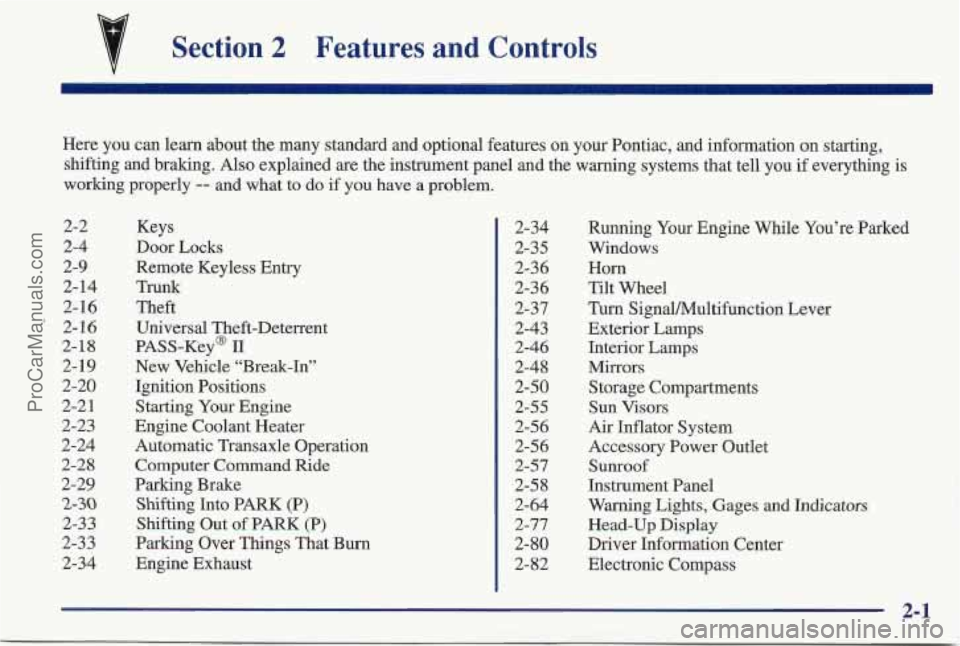
Section 2 Features and Controls
Here you can learn about the many standard and optional features on your Pontiac, and information on starting,
shifting and braking. Also explained are the instrument panel and the warning systems that tell you if everything
is
working properly -- and what to do if you have a problem.
2-2
2-4
2-9
2- 14
2-16
* 2-16
2-18
2-19
2-20
2-2
1
2-23
2-24
2-28
2-29
2-30
2-33
2-33
2-34 Keys
Door Locks
Remote Keyless Entry Trunk
Theft
Universal Theft-Deterrent
PASS-Key@
I1
New Vehicle “Break-In”
Ignition Positions
Starting
Your Engine
Engine Coolant Heater
Automatic Transaxle Operation Computer Command Ride
Parking Brake
Shifting Into PARK (P)
Shifting Out of PARK (P)
Parking Over Things That Bum
Engine Exhaust 2-34
2-3
5
2-3 6
2-36
2-37
1 2-43
~ 2-46
2-48
2-50
2-55
2-56
2-56
2-57
2-5 8
2-64
2-77
2-80
2-82 Running
Your Engine While You’re Parked
Windows
Horn
Tilt Wheel
Turn SignalMultifunction Lever
Exterior Lamps
Interior Lamps
Mirrors
Storage Compartments
Sun Visors
Air Inflator
System
Accessory Power Outlet
Sunroof
Instrument Panel
Warning Lights, Gages
and Indicators
Head-Up Display
Driver Information Center
Electronic Compass
2-.l
ProCarManuals.com
Page 74 of 405
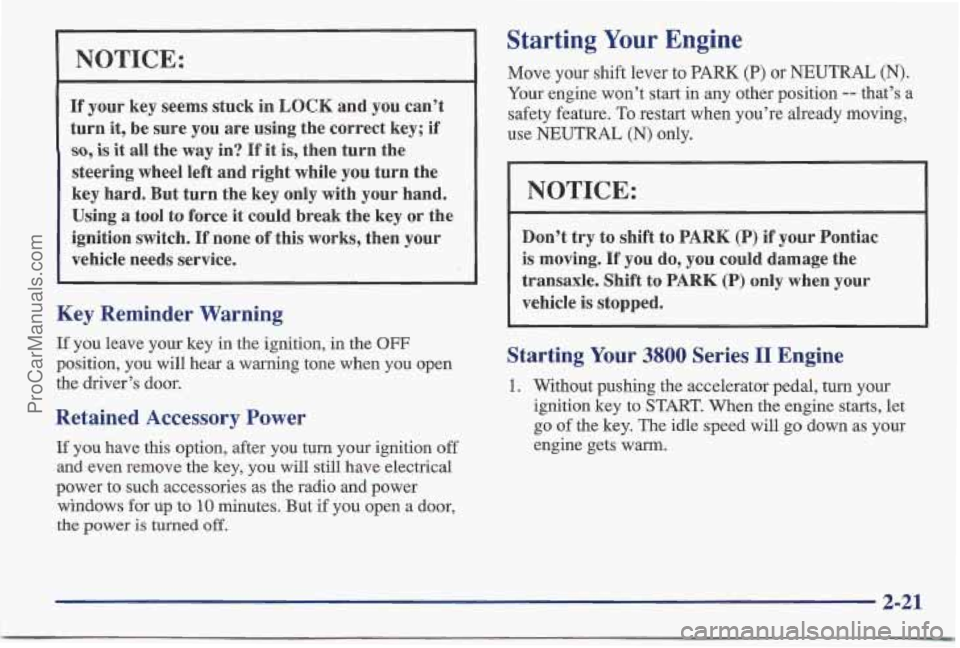
NOTICE:
If your key seems stuck in LOCK and you can’t
turn
it, be sure you are using the correct key; if
so, is it all the way in? If it is, then turn the
steering wheel left and right while you turn the
key hard. But turn the key only with your hand.
Using
a tool to force it could break the key or th’e
ignition switch.
If none of this works, then your
vehicle needs service.
Key Reminder Warning
If you leave your key in the ignition, in the OFF
position, you will hear a warning tone when you open
the driver’s door.
Retained Accessory Power
If you have this option, after you turn your ignition off
and even remove the key, you will
still have electrical
power to such accessories as the radio and power
windows for up
to 10 minutes. But if you open a door,
the power is turned off.
Starting Your Engine
Move your shift lever to PARK (P) or NEUTRAL (N).
Your engine won’t start in any other position
-- that’s a
safety feature.
To restart when you’re already moving,
use
NEUTRAL (N) only.
I
NOTICE:
Don’t try to shift to PARK (P) if your Pontiac
is moving.
If you do, you could damage the
transaxle. Shift to
PARK (P) only when your
vehicle is stopped.
Starting Your 3800 Series I1 Engine
1. Without pushing the accelerator pedal, turn your
ignition key to
START. When the engine starts, let
go of the key. The idle speed will go down as your
engine gets warm.
2-21
ProCarManuals.com
Page 75 of 405
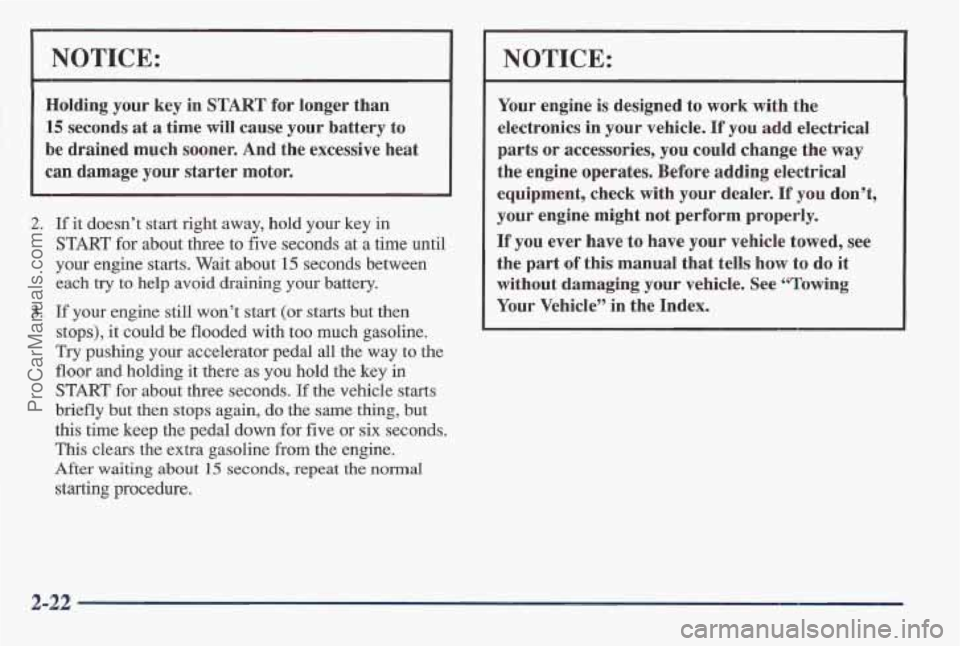
NOTICE:
Holding your key in START for longer than
15 seconds at a time will cause your battery to
be drained much sooner. And the excessive heat
can damage
your starter motor.
2. If it doesn’t start right away, hold your key in
START for about three to five seconds at a time until
your engine starts. Wait about
15 seconds between
each try to help avoid draining your battery.
3. If your engine still won’t start (or starts but then
stops), it could be flooded with too much gasoline.
Try pushing your accelerator pedal all the way to the
floor and holding
it there as you hold the key in
START for about three seconds. If the vehicle starts
briefly
but then stops again, do the same thing, but
this time keep the pedal down for five or six seconds.
This clears the extra gasoline from the engine.
After
waiting about 15 seconds, repeat the normal
starting procedure.
NOTICE:
Your engine is designed to work with the
electronics in your vehicle. If you add electrical
parts or accessories, you could change the way
the engine operates. Before adding electrical
equipment, check with your dealer.
If you don’t,
your engine might not perform properly.
If you ever have to have your vehicle towed, see
the part
of this manual that tells how to do it
without damaging your vehicle. See “Towing
Your Vehicle” in the Index.
2-22
ProCarManuals.com
Page 76 of 405
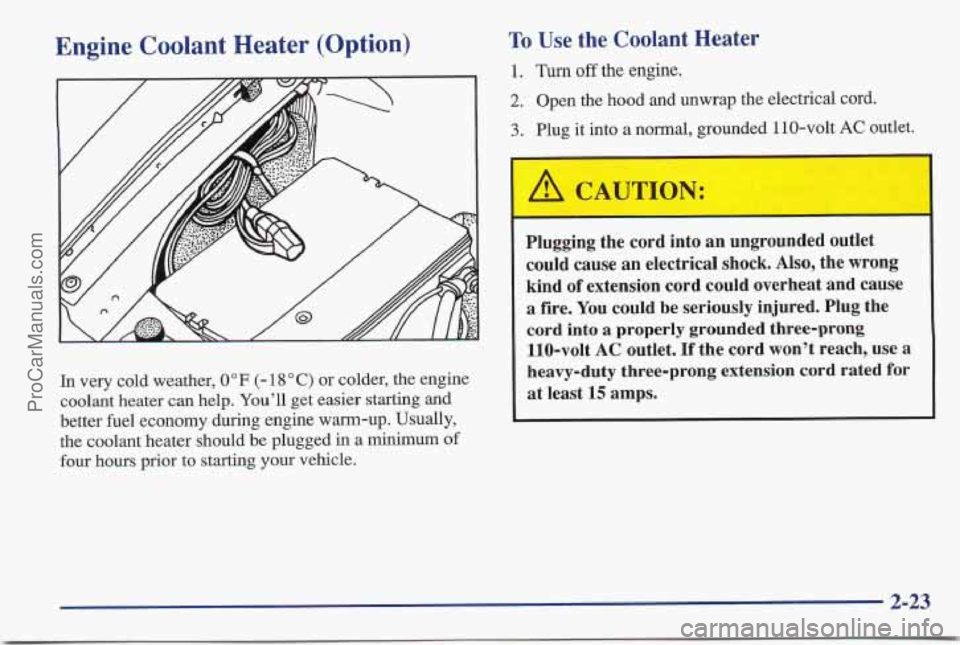
Engine Coolant Heater (Option)
In very cold weather, 0 OF (- 18 O C) or colder, the engine
coolant heater can help. You’ll get easier starting and
better fuel economy during engine warm-up. Usually,
the coolant heater should be plugged in
a minimum of
four hours prior to starting your vehicle.
To Use the Coolant Heater
1. Turn off the engine.
2. Open the hood and unwrap the electrical cord.
3. Plug it into a normal, grounded 11 O-volt AC outlet.
m
A CAUTION:
Plugging the cord into an ungrounded outlet
could cause an electrical shock. Also, the wrong
kind of extension cord could overheat and cause
a fire. You could be seriously injured. Plug the
cord into a properly grounded three-prong
110-volt
AC outlet. If the cord won’t reach, use a
heavy-duty three-prong extension cord rated for
at least 15 amps.
2-23
ProCarManuals.com
Page 77 of 405
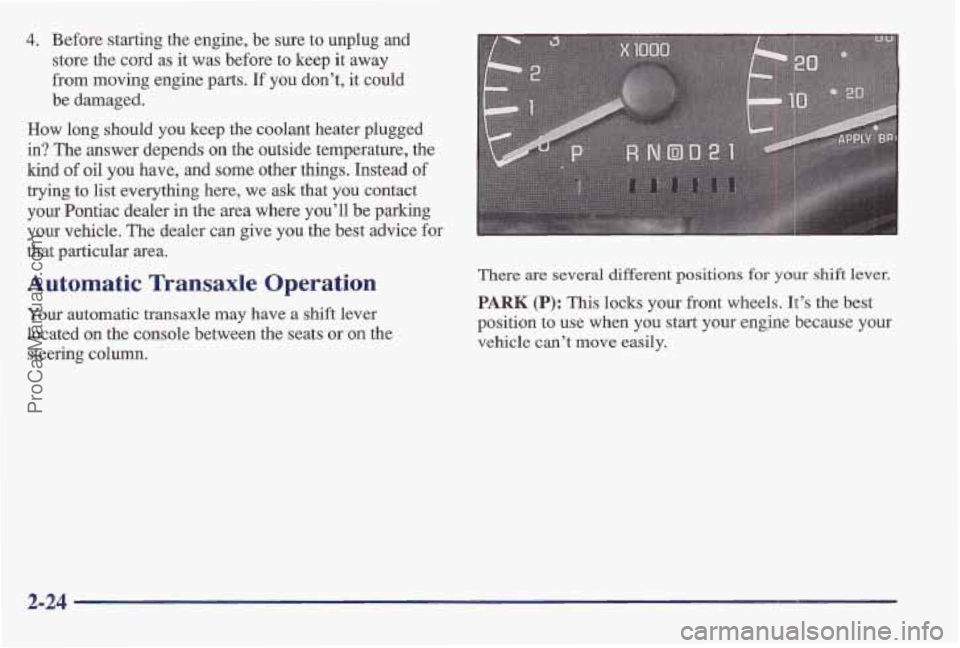
4. Before starting the engine, be sure to unplug and
store the cord as it was before to keep it away
from moving engine parts.
If you don’t, it could
be damaged.
How long should you keep the coolant heater plugged
in? The answer depends on the outside temperature, the
kind of oil you have, and some other things. Instead of
trying to list everything here, we ask that you contact
your Pontiac dealer in the area where you’ll be parking
your vehicle. The dealer can give you the best advice for
that particular
area.
Automatic Transaxle Operation
Your automatic transaxle may have a shift lever
located on the console between the seats or
on the
steering column.
There are several different positions for your shift lever.
PARK (P): This locks your front wheels. It’s the best
position
to use when you start your engine because your
vehicle can’t move easily.
2-24
ProCarManuals.com
Page 78 of 405
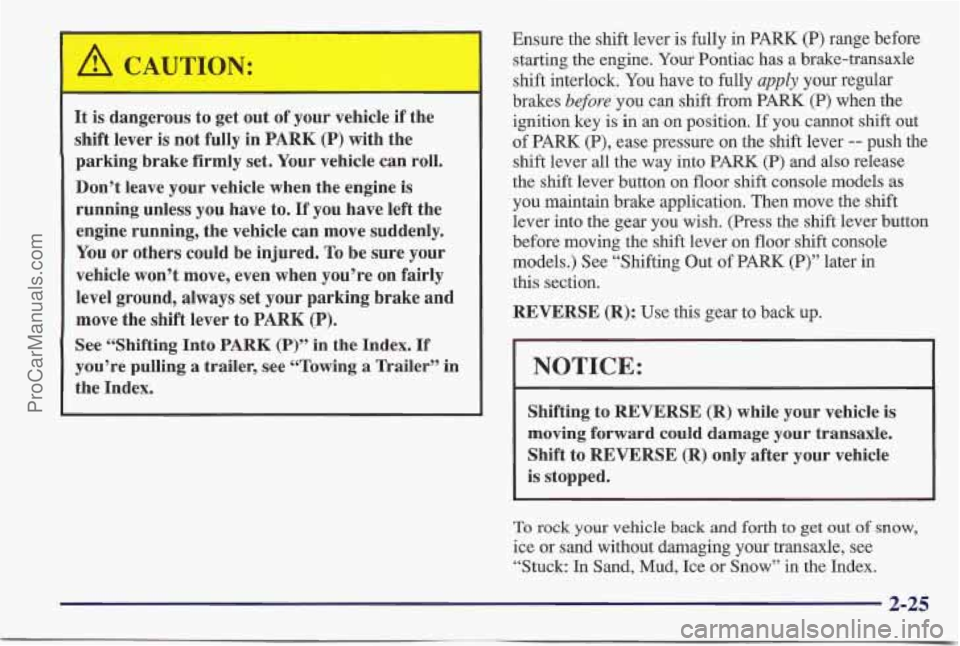
r
It is dangerous to get out of your vehicle if the
shift lever is not fully in
PARK (P) with the
parking brake firmly set. Your vehicle can
roll.
Don’t leave your vehicle when the engine is
running unless you have to. If you have left the
engine running, the vehicle can move suddenly.
You or others could be injured. To be sure your
vehicle won’t move, even when you’re on fairly
level ground, always
set your parking brake and
move the shift lever
to PARK (P).
See “Shifting Into PARK (P)” in the Index. If
you’re pulling a trailer, see “Towing a Trailer” in
the Index. Ensure
the shift lever is fully in PARK
(P) range before
starting the engine. Your Pontiac has a brake-transaxle
shift interlock. You have to fully
apply your regular
brakes
before you can shift from PARK (P) when the
ignition key is in an on position. If you cannot shift out
of PARK (P), ease pressure on the shift lever
-- push the
shift lever all the way into
PARK (P) and also release
the shift lever button
on floor shift console models as
you maintain brake application. Then move the shift lever into the gear you wish. (Press the shift lever button
before moving the shift lever on floor shift console
models.) See “Shifting Out of PARK
(P)” later in
this section.
REVERSE (R): Use this gear to back up.
I NOTICE:
Shifting to REVERSE (R) while your vehicle is
moving forward could damage your transaxle.
Shift to
REVERSE (R) only after your vehicle
is stopped.
To rock your vehicle back and forth to get out’of snow,
ice or sand without damaging your transaxle, see
“Stuck: In
Sand, Mud, Ice or Snow” in the Index.
2-25
- ProCarManuals.com
Page 128 of 405
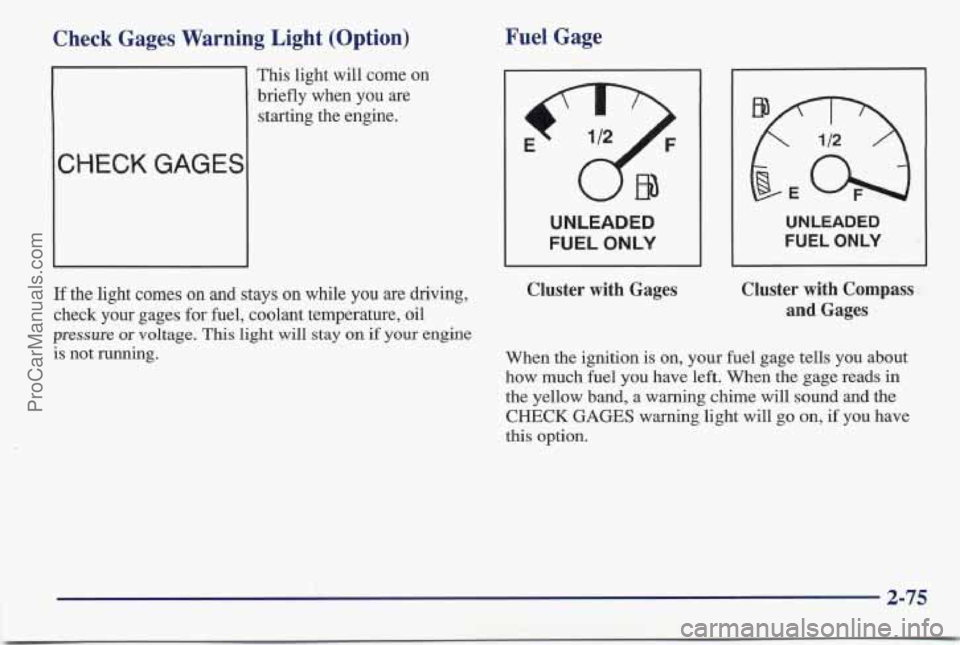
Check Gages Warning Light (Option)
1
This light will come on
briefly when you are
starting the engine.
CHECK GAGES
Fuel Gage
UNLEADED
FUEL
ONLY
UNLEADED
FUEL ONLY
If the light comes on and stays on while you are driving,
check your gages
for fuel, coolant temperature, oil
pressure or voltage. This light will stay on if your engine
is not running.
Cluster with Gages Cluster with Compass
and Gages
When
the ignition is on, your fuel gage tells you about
how much fuel you have
left. When the gage reads in
the yellow band, a warning chime will sound and the
CHECK
GAGES warning light will go on, if you have
this option.
2-75
ProCarManuals.com
Page 196 of 405
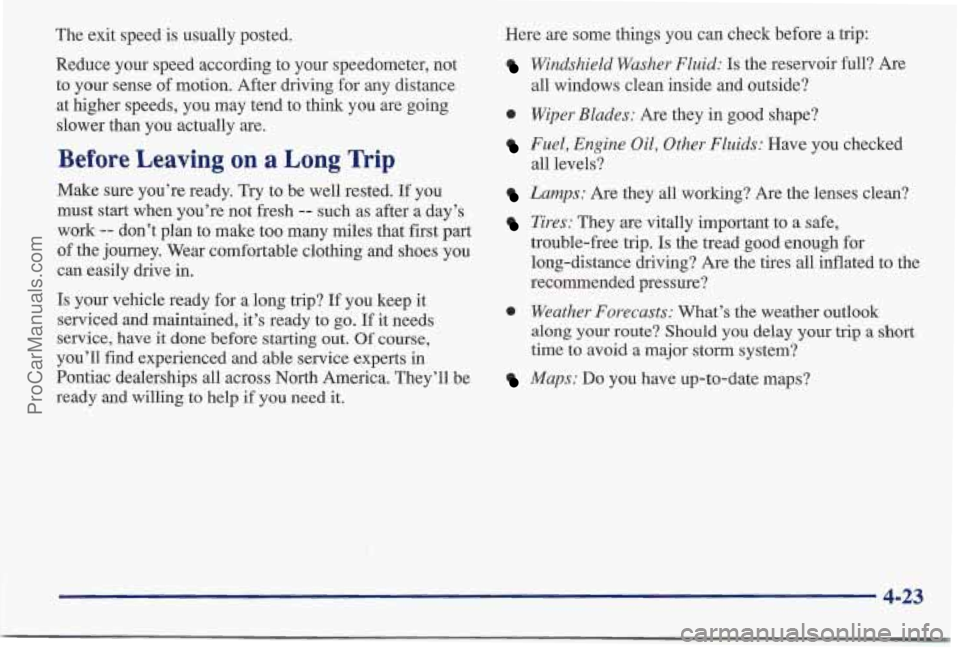
The exit speed is usually posted.
Reduce your speed according to your speedometer, not
to your sense of motion. After driving for any distance
at higher speeds, you may tend to think you are going
slower than you actually are.
Before Leaving on a Long Trip
Make sure you’re ready. Try to be well rested. If you
must start when you’re not fresh
-- such as after a day’s
work
-- don’t plan to make too many miles that first part
of the journey. Wear comfortable clothing and shoes you
can easily drive in.
Is your vehicle ready for a long trip?
If you keep it
serviced and maintained, it’s ready to go.
If it needs
service, have
it done before starting out. Of course,
you’ll find experienced and able service experts
in
Pontiac dealerships all across North America. They’ll be
ready and willing
to help if you need it.
Here are some things you can check before a trip:
Windshield Washer Fluid: Is the reservoir full? Are
all windows clean inside and outside?
0 Wiper Blades: Are they in good shape?
Fuel, Engine Oil, Other Fluids: Have you checked
all levels?
Lamps: Are they all working? Are the lenses clean?
Tires: They are vitally important to a safe,
trouble-free trip.
Is the tread good enough for
long-distance driving? Are the tires all inflated to the
recommended pressure?
0 Weather Forecasts: What’s the weather outlook
along your route? Should you delay your trip a short
time to avoid a major storm system?
Maps: Do you have up-to-date maps?
4-23
ProCarManuals.com
Page 214 of 405
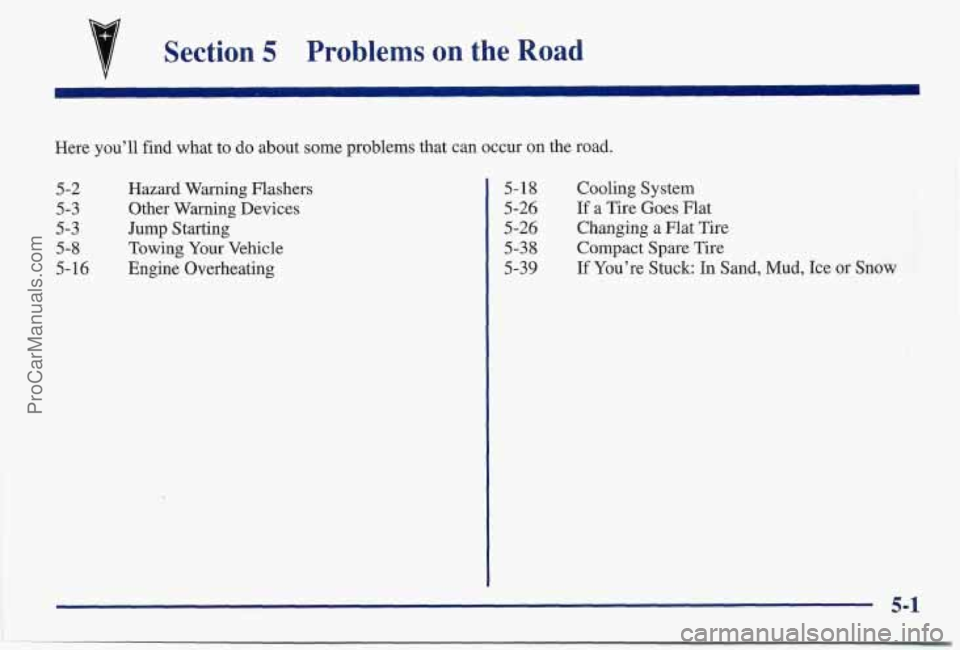
Section 5 Problems on the Road
Here you’ll find what to do about some problems that can occur on the road.
5-2
5-3
5-3
5-8
5-16 Hazard Warning
Flashers
Other Warning Devices
Jump Starting
Towing Your Vehicle
Engine Overheating 5-18
Cooling System
5-26 Changing a Flat Tire
5-38 Compact Spare Tire
5-39 If You’re Stuck: In Sand, Mud, Ice or Snow
5-26 If a Tire Goes Flat
5-1
ProCarManuals.com
Page 269 of 405
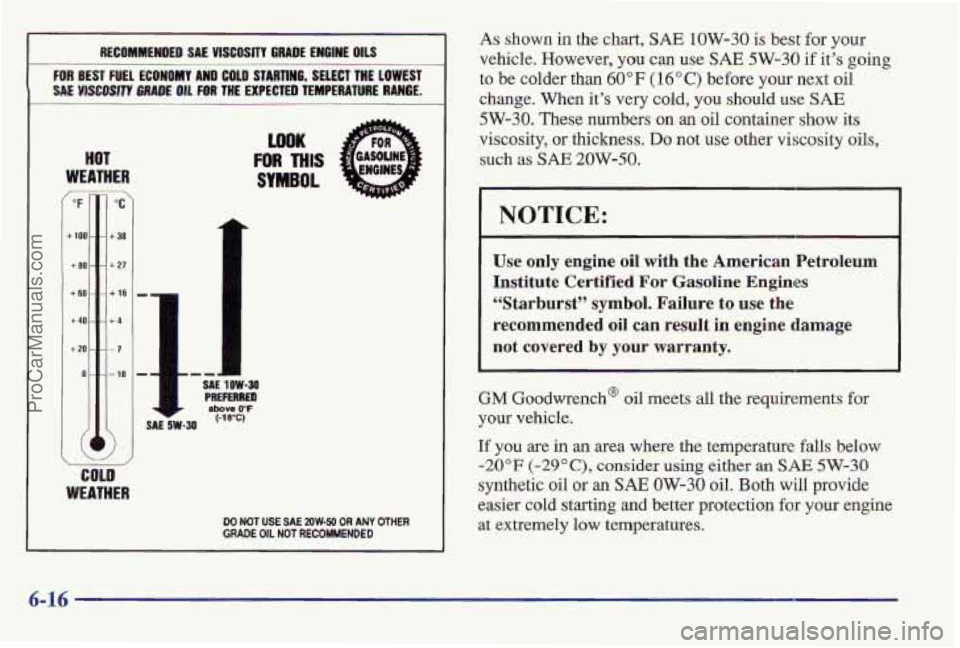
RECOMMENDED SAE VISCOSITY GRADE ENGINE OILS
FOR BEST FUEL ECONOMY AND COLD STIIRTING, SELECT THE LOWEST
SAf YSCDSJTY =DE OIL FOR THE EXPECTED TEMPERATURE RANGE.
HOT
WEATHER I
“F
k 100 -
+ 80 -
+60.
+40-
+ 20.
0.
7 “C
. +30
- +27
- + 16
- +4
--7
- -18
WEATHER
LOOK
FOR THIS
SYMBOL
I - SAE 5W-M -
DQ NOT USE SAE ZOW-50 OR ANY OTHER GRADE OIL NOT RECOMMENDED
As shown in the chart, SAE 1OW-30 is best for your
vehicle. However, you can
use SAE 5W-30 if it’s going
to be colder than 60
OF ( 16 O C) before your next oil
change. When it’s
very cold, you should use SAE
5W-30. These numbers on an oil container show its
viscosity,
or thickness. Do not use other viscosity oils,
such
as SAE 2OW-50.
NOTICE:
Use only ‘engine oil with thle American Petroleum
Institute Certified For Gasoline Engines
“Starburst” symbol. Failure
to use the
recommended oil can result
in engine damage
not covered by your warranty.
GM Goodwrench@ ail meets all the requirements for
your vehicle.
If
you are in an area where the temperature falls below
-20°F (-29”C), consider using either an SAE 5W-30
synthetic oil or an SAE OW-30 oil. Both will provide
easier cold starting
and better protection for your engine
at extremely low temperatures.
6-16
ProCarManuals.com